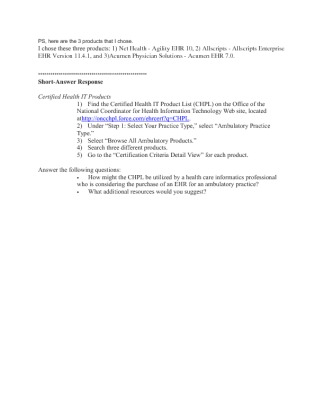Certified Health IT Products
in Nursing by radykalYour Price: $10.00 (30% discount)
You Save: $4.29
Description
**A+ Work! Use this paper as a guide to help you get a great grade!
BIO 101 Module 3 - SLP
PRINCIPLES OF TAXONOMY
Overview
As you have learned in Modules 1 and 2, prokaryotes share many common features that differentiate them from eukaryotes, such as:
Lack of nuclear membrane, unicellularity, division by binary-fission and generally small size.
As introduced on the Home page of Module 3, various species differ and can be classified into taxonomic groups based on several characteristics. One characteristic commonly used to differentiate an organism as belonging to one species or another is the potential for the individuals to reproduce sexually and produce viable offspring. However, this characteristic cannot be applied to prokaryotes, and so their identification and classification is often determined based on:
Phylogeny: All bacteria stem from a common ancestor and diversified since, consequently possess different levels of evolutionary relatedness
Metabolism: Different bacteria may have different metabolic abilities
Environment: Different bacteria thrive in different environments, such as high/low temperature and salt
Morphology: There are many structural differences between bacteria, such as cell shape, Gram stain (number of lipid bilayers) or bilayer composition
Pathogenicity: Some bacteria are pathogenic to plants or animals
All microbial metabolisms can be arranged according to three principles:
- How the organism obtains carbon for synthesizing cell mass:
autotrophic – carbon is obtained from carbon dioxide (CO2)
heterotrophic – carbon is obtained from organic compounds
mixotrophic – carbon is obtained from both organic compounds and by fixing carbon dioxide
- How the organism obtains reducing equivalents used either in energy conservation or in biosynthetic reactions:
lithotrophic– reducing equivalents are obtained from inorganic compounds
organotrophic – reducing equivalents are obtained from organic compounds
- How the organism obtains energy for living and growing:
chemotrophic – energy is obtained from external chemical compounds
phototrophic – energy is obtained from light
In practice, these terms are almost freely combined. Typical examples are
as follows:
chemolithoautotrophs obtain energy from the oxidation of inorganic compounds and carbon from the fixation of carbon dioxide. ie: Nitrifying bacteria
photolithoautotrophs obtain energy from light and carbon from the fixation of carbon dioxide, using reducing equivalents from inorganic compounds.
For example: Cyanobacteria are photosynthetic autotrophs. Cyanobacteria split water, H2O, molecules and use the electrons to reduce carbon in photosynthesis. Water is the electron donor. However, Chlorobiaceae and Chromatiaceae are also photosynthetic autotrophs, but they use hydrogen sulfide H2S as the electron donor, or reducing equivalent donor.
chemolithoheterotrophs obtain energy from the oxidation of inorganic compounds, but cannot fix carbon dioxide (CO2).
chemoorganoheterotrophs obtain energy, carbon, and reducing equivalents for biosynthetic reactions by breaking apart organic compounds (made by photoautotrophs). Examples: most bacteria, e. coli, Bacillus spp., Actinobacteria
photoorganoheterotrophs obtain energy from light, carbon and reducing equivalents for biosynthetic reactions from organic compounds. Some species are strictly heterotrophic, many others can also fix carbon dioxide and are mixotrophic.
Examples: Rhodobacter, Rhodopseudomonas,Rhodospirillum, Rhodomicrobium, Rhodocyclus, Heliobacterium, Chloroflexus (alternatively to photolithoautotrophy with hydrogen)
For this SLP assignment, you will continue to analyze the paper by
Urakawa et al. (2012) by considering the characteristics that allow us to classify the prokaryotic organisms in this study as belonging to different Domains. You will use the
website: UC Berkeley's virtual exhibit hall and resource on taxonomy and phylogeny, to complete this assignment.
SLP Assignment
Review your definitions of Archaea and ammonia-oxidizing bacteria from Module 1. Begin at, webpage titled "Welcome to the Phylogeny Wing. Select the link
"Phylogeny of Life" within the first of the "four ways to get started." You will an overview of the relationship between DNA and the Three Domains of Life. Use this page to begin the research necessary to address these topics in a 3-4 page paper:
- What general characteristics determine whether a prokaryote belongs to the Archaea or Bacteria domain?
-
Define DNA and RNA. What role do DNA and RNA play in this determination?
-
What role does the metabolism play in classifying Nitrosococcus oceani and Nitrosopumilus maritimusas Archaea or Bacteria?
- Do either of these organisms normally thrive in an environment where crude oil is abundant? What other microbes live in this type of environment?


